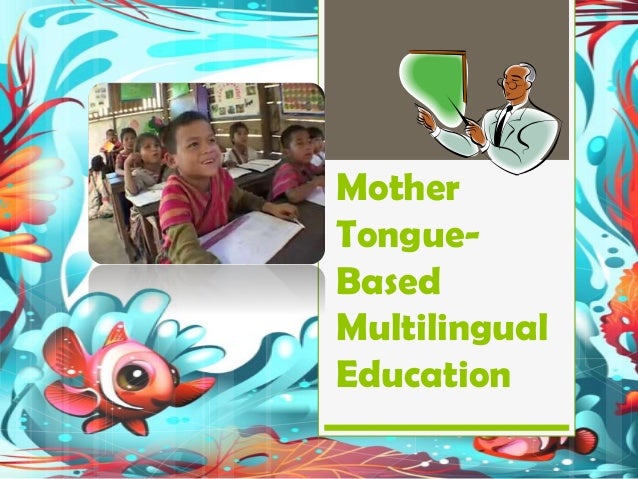- Worldwide nearly 7000 languages are spoken today. Many languages are spoken by ethnic minorities who are educationally and economically disadvantaged because.
- The conference brought together over 300 practitioners from 30 countries, reflecting the incredible diversity of the Asia-Pacific region and clearly demonstrating the importance of Mother Tongue-Based Multilingual Education (MTB-MLE). This brochure summarises some of the key messages from this landmark event. What role can language.
- Mother Tongue Based Multilingual Education Programs Children from non-dominant language communities are often forced to begin their formal education in classrooms where their language is not allowed and the medium of instruction is a language they.
- Mother Tongue-Based Multilingual Education Quarter 1 – Module 32 Invented and Conventional Spelling This instructional material was collaboratively developed and reviewed by educators from public schools. We encourage teachers and other education stakeholders to email their feedback, comments and recommendations.
In Southeast Asia, this is apparent in a rising number of educational programs that utilize this approach. However, the Philippines is the only country in Southeast Asia to have instituted a national policy requiring mother tongue-based multilingual education (MTB-MLE) in the primary school years.
Abstract
In June 2012, the K to 12 Curriculum was implemented in the Philippines. Basic education is now thirteen years instead of the usual ten years. In the K to 12 Curriculum, the elementary grades will focus on the core learning areas namely: languages, mathematics, science and social studies. One of the highlights of the K to 12 Curriculum is the use of the eight major Philippine languages to teach Kindergarten to Grade 3 students. The Department of Education adopted the “Mother Tongue-Based Multilingual Education (MTB-MLE)” after pilot tests showed students learn better when the language used at home is also used in the classroom. This study aimed to determine the reactions and attitudes of the teachers and the problems they encountered on the implementation of the Multilingual Education and the Teaching of Mother Tongue in the Philippines. The study utilized quantitative and qualitative research methods through document analysis, survey, interview and observation. Triangulation of data in terms of method of gathering and validation was undertaken. This paper focused in selected public elementary schools in three municipalities in Northern Isabela in the Cagayan Valley Region namely Cabagan, San Pablo, Santa Maria and Santo Tomas. Survey questionnaire, interview guide and observation checklist were used to document the problems, attitudes and perceptions of K to 3 teachers in the implementation of MTB-MLE for the K to 12 program Results showed that the feelings, reactions and attitudes of the teachers on the implementation of the MTB-MLE are generally favorable. However, the teachers encountered problems on availability of instructional materials and facilities.
Author Information
Eileen Bernardo, Isabela State University, The Philippines
Nilda Aggabao, Isabela State University, The Philippines
Mother Tongue-based Multilingual Education Thesis Statement
Jaine Tarun, Isabela State University, The Philippines
Paper Information

Conference: ACEID2018
Stream: Primary and secondary education
This paper is part of the ACEID2018 Conference Proceedings (View)
Full Paper
View / Download the full paper in a new tab/window
Mother Tongue- Based Multilingual Education (MTB-MLE)
One of the changes in Basic Education Curriculum brought about by the new K-12 program is the introduction of Mother Tongue- Based Multilingual Education (MTB-MLE) specifically in Kindergarten, Grades 1, 2 and 3 to support the goal of “ Every Child- A- Reader and A –Writer” by Grade 1.”
Mother Tongue Based Multilingual Education Deped
MTB-MLE refers to “first-language-first” education that is, schooling which begins in the mother tongue and transitions to additional languages particularly Filipino and English. It is meant to address the high functional illiteracy of Filipinos where language plays a significant factor. Since the child’s own language enables her/ him to express him/herself easily, then, there is no fear of making mistakes. It encourages active participation by children in the learning process because they understand what is being discussed and what is being asked of them. They can immediately use their mother tongue to construct and explain their world, articulate their thoughts and add new concepts to what they already know.
Currently, there are twelve (12) major languages or lingua franca that shall be language of instruction. The major languages are a) Tagalog b) Kapampangan c) Pangasinense d) Iloko e) Bikol f) Cebuano g) Hiligaynon h) Waray i) Tausug j) Maguindanaoan k) Maranao; l) Chabacano.
Mylearningplan Tusd
With this challenge posted about MTB- MLE, Capitol University, College of Education plans to institute the MTB-MLE Teacher Development Program through its Center for Professional and Continuing Education (CPCE) with focus on teaching reading in the mother tongue and the production of reading materials. Local stories, poems, biographies, folktales, legends, jokes, riddles as well as the traditional oral literature will be put into writing that will become part of the leaching-learning repertoire. The plan is to localize the Cebuano/Visayan materials to Cagayan de Oro context and linguistic use. Next focus will be the production of materials of the Indigenous Peoples found in the region.